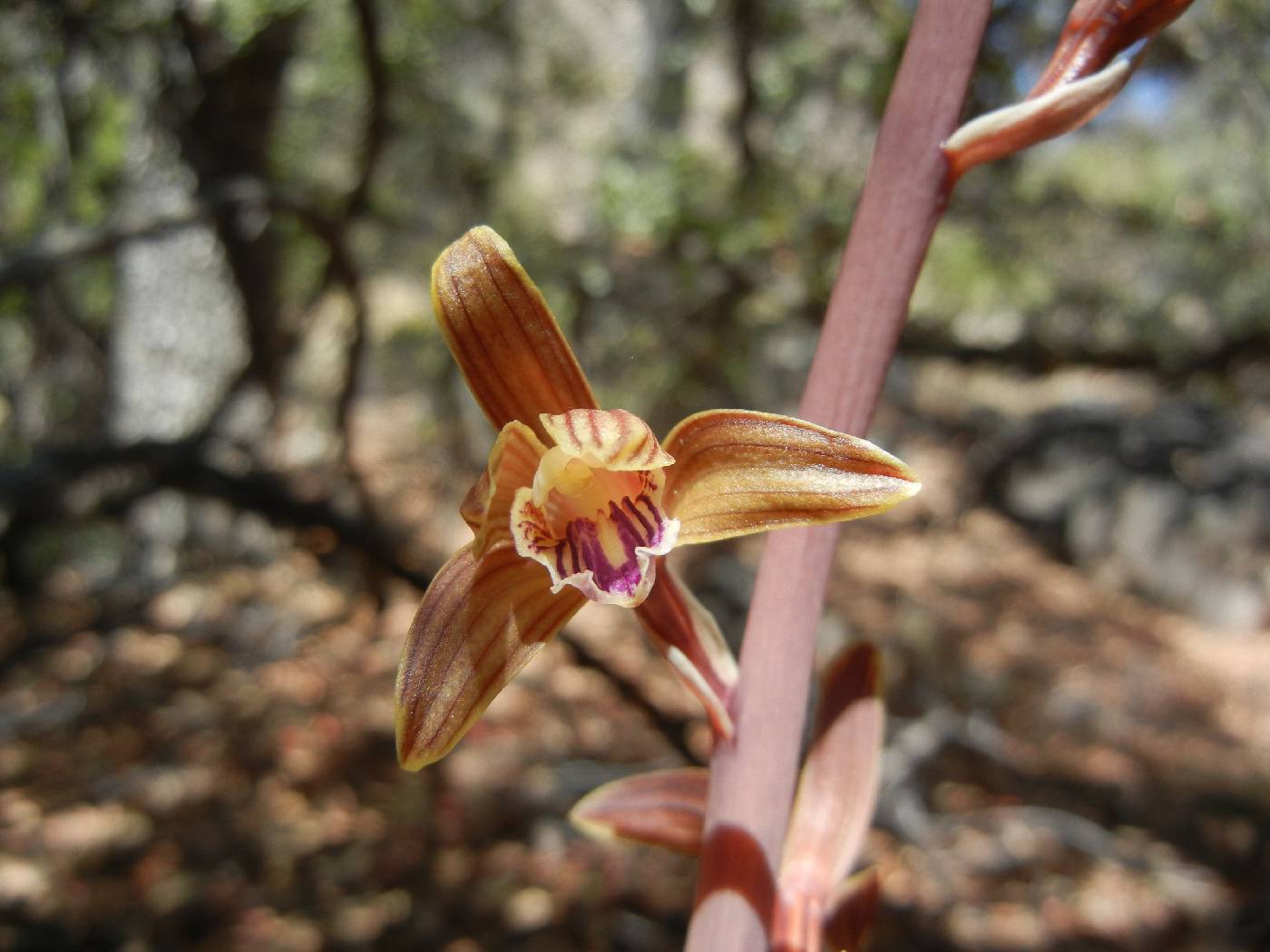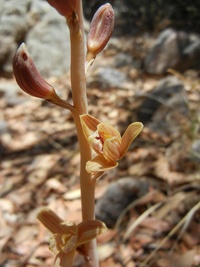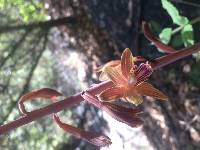
|
|
|
|
Family: Orchidaceae
Arizona Crested-Coralroot, more...spiked crested coralroot
[Hexalectris arizonica (S. Watson) A.H. Kennedy & L.E. Watson] |
Stems pinkish red, pale pink-yellow, or pink-white, 15-70 cm; sheathing bracts 3-5. Flowers cleistogamous or chasmogamous, apparently autogamous; sepals and petals usually not apically recurved on chasmogamous flowers, yellow-tan, pinkish, red-brown, or purple-brown with dull magenta, faint pink-brown to purple-brown veins, margins pale; dorsal sepal lanceolate to oblong, 15-18 × 2.7-4.5 mm; lateral sepals 13-15 × 4-7 mm; petals 14-16 × 4-5 mm; lip 12-14.5 × 10-12 mm, white or creamy white with darkly colored veins and paler margin; lamellae central, pale, 0.2-0.7 mm; column 11-14 mm; rostellum absent; anthers whitish. Capsules 16-25 × 8-15 mm. Flowering May--Aug. In organic mesic to dry soil over limestone or sandstone, in juniper, pine, and oak woodlands; 100--600 m (c Tex.), 1600--2000 m (west); Ariz., N.Mex., Tex.; Mexico. This autogamous and florally reduced segregate of Hexalectris spicata has been thought to be of hybrid origin, derived either from H. spicata var. spicata and H. nitida, or less likely from the former taxon and H. revoluta (P. M. Catling and V. S. Engel 1993). In Texas this plant tends to begin flowering later than the typical variety, from June and July (P. M. Catling and V. S. Engel 1993), as it does in Arizona and New Mexico, where it flowers in July and August (R. A. Coleman).
FNA 2002, Caitling and Engel 1993 Duration: Perennial Nativity: Native Lifeform: Forb/Herb General: Stems pinkish red to pale pink yellow or pink white, 15-70 cm, with 3-5 sheathing bracts. Leaves: Reduced to scales. Flowers: The 5-25 flowers can be self fertilizing, the sepals and petals not apically recurved on the flowers that out cross, these yellow-tan to pinkish, red-brown with magenta to purple veins, the margins pale, the outer sepal lanceolate to oblong, 15-18 mm long and 2.5-4.5 mm wide, the inner sepals 13-15 mm long and 4-7 mm wide, the petals similarly sized, with a lip 12-14.5 mm long and 10-12 mm wide, white to creamy white with darkly colored veins, the column 11-14 mm, the rostellum absent. Fruits: Capsule 16-25 mm long. Ecology: Found in mesic to dry soils often in limestone to sandstone in juniper, pine, and oak woodlands from 5,000-7,000 ft (1524-2134 m), flowers May-August. Notes: FNA suggests this is of hybrid origin and told apart from var. spicata by virtue of the latter only having flowers that outcross, having a rostellum, and with petals that are generally larger. Very similar to Corallorhiza but pay attention to the presence of sheathing bracts in this species to distinguish. Ethnobotany: Unknown Etymology: Hexalectris comes from Greek hex for six and alectryon for rooster, referring to the crests on the lip petal, while spicata means spicate for the spicate inflorescence, and arizonica means of or from Arizona. Synonyms: None Editor: SBuckley 2011 |
This project was made possible in part by the Institute of Museum and Library Services [MG-70-19-0057-19].
Powered by Symbiota





